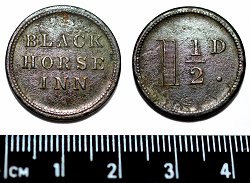the history of yeovil's pubs
PUBS HOME PAGE |
PUBS INTRODUCTION |
PUBS BY NAME |
BEERHOUSES |
black horse
Reckleford
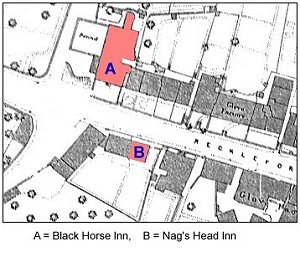 There
has been a Black
Horse Inn (shown
as 'A' on the
1886 map at
right) on this
site since at
least the
1830's, as
witnessed by the
list of
licensees below.
There
has been a Black
Horse Inn (shown
as 'A' on the
1886 map at
right) on this
site since at
least the
1830's, as
witnessed by the
list of
licensees below.
However it seems that this did not start life as a beerhouse, but as a full public house, since it has been named as the Black Horse since its first mention - in Robson's 1835 Trade Directory. However the present building probably dates from the 1920's or 1930's.
The address of the pub used to be Reckleford Hill but the road name changed to Reckleford around 1800. The map here, based on the 1886 Ordnance Survey map still labeled it as Reckleford Hill. Note the pound at the side of the Black Horse. Note also the two glove factories either side of the road.
The earlier pub survived a fire in 1865 (see Documentation below) and the later building survived the widening of Reckleford in the mid-1960's unlike nearly every other building either side of the original un-widened Reckleford, including its near neighbour on the other side of the road, the Nag's Head.
|
|
|
This is a public house 'check' from my collection, probably issued in the late nineteenth or early twentieth century, from the Black Horse Inn, for the value 1½d. On
the
obverse
is
"BLACK"
above
"HORSE"
above
"INN",
the
reverse
has just
the
value 1½d.
Made of
brass,
it is
just
under
22mm in
diameter
and is
1.7mm
thick. |
Public house 'checks' were frequently used in pub games, such as skittles or quoits where, for instance, players would 'chip in' a check to the 'kitty' which would be won by the winning team to redeem at the bar. By issuing checks a landlord could guarantee they would be spent in his establishment only.
See also Yeovil Trade Tokens and Checks
By the 1890s the Black Horse Inn was a tied house of the Royal Osborne Brewery, with a long lease owned by Earle Vincent. When Vincent died in 1893 his estate was sold off the following year which included "the Black Horse Inn, Reckleford, tenanted by Mr Job Forsey at £18 (about £1,800 per annum at today's value)." The brewery and the Black Horse were bought by Jonathan Drew Knight.
The following is from the Western Gazette of 07 September 2012.
|
Pub
landlord
sickened
by theft
of air
charity
cash Landlord Andy Gurzynski, 50, has been left deeply upset by the theft. He said: “It is absolutely gut-wrenching. I am devastated for my regulars and the charity. It is estimated there was about £5,000 in the container and we were so close to it being full and handing it over." |
|
Yeovilians remember... From me - "At one time, certainly during the early 1980's (when I lived in the Avenue and the Black Horse was my local), an off-license operated via the now-blocked door seen in the photograph below facing the Avenue." |
![]()
The pub has had a very long string of landlords, none of whom seem to have lasted much more than a few years. Little is known about the first named licensee, George Bengefield, other than he was listed as a smith in Back Kingston. The Bengefields were a Wincanton family.
George Andrews was listed in the 1841 census as an innkeeper in Reckleford. Although the pub was not named its proximity to Higher Kingston in the census could only mean it was the Black Horse. George was born about 1811 but not in Somerset. He was living at the Black Horse with his Somerset-born wife, Ann, and their three daughters, none of whom were born in Somerset. There was no trace of George or his family in Yeovil after 1841 and they must have left by 1842.
Charles Chalker was born in 1794 in Keinton Mandeville and was listed in Pigot’s 1842-4 Directory as the licensee of the Black Horse. Although in the 1846 Keinton Mandeville Poll Book Charles was listed by virtue of holding a freehold house and garden in Keinton albeit owned by John Baily. In the 1851 census he gave his occupation as a stone mason employing 10 men and inn keeper. He lived with his wife, Mary Ann, their two daughters and a servant at the Black Horse on Reckleford Hill. Two lodgers were also recorded. He died in Yeovil in the winter of 1857.
William Thorne, born in 1827 in Stoke sub Hamdon, was the next licensee. He married Caroline Park in Yeovil in July 1857 and in the 1861 census he was listed as the inn keeper and they were living at the Black Horse with their baby son, Henry William, and Caroline's young sister, Susan, worked there as a servant. Both William and Caroline disappear from the records after this date.
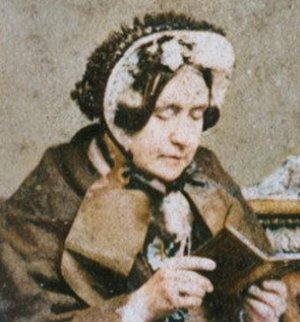 Elizabeth
Gregory
(colourised
photograph at
left) was born
in 1817 at
Charlton
Horethorne, ten
miles northeast
of Yeovil, the
daughter of
labourer John
Gregory. She
married Henry
Sugg, son of
labourer William
Sugg, on 29 July
1838 at South
Street Chapel,
Yeovil. On her
marriage
certificate she
was noted as a
glover living in
Reckleford and
Henry as a
mason. Neither
she nor Henry
could write and
both made their
mark on the
certificate. In
the 1841 census
Henry was listed
as a bricklayer
and he and
Elizabeth,
together with
their baby son,
William, were
living in
Reckleford.
Elizabeth
Gregory
(colourised
photograph at
left) was born
in 1817 at
Charlton
Horethorne, ten
miles northeast
of Yeovil, the
daughter of
labourer John
Gregory. She
married Henry
Sugg, son of
labourer William
Sugg, on 29 July
1838 at South
Street Chapel,
Yeovil. On her
marriage
certificate she
was noted as a
glover living in
Reckleford and
Henry as a
mason. Neither
she nor Henry
could write and
both made their
mark on the
certificate. In
the 1841 census
Henry was listed
as a bricklayer
and he and
Elizabeth,
together with
their baby son,
William, were
living in
Reckleford.
Their location in the census puts them immediately between the Black Horse and Higher Kingston - maps of the time show no houses actually on Reckleford at this location and they must have been living in a small cottage immediately behind the Black Horse on little more than a short, narrow track which would later become the location of The Avenue.
In the 1851 census Henry was again listed as a mason and they were living in the same cottage, although son William had presumably died and was no longer present. Children living with them were Walter aged 9, Emily aged 6, Albert aged 4 and Ellen aged 1. By the time of the 1861 census Henry was describing himself as a master mason employing two men and two boys. Living with them were Emily, Albert and Ellen as well as William aged 8 (confirming the death of the earlier son called William) and Elizabeth, known as Lizzie, aged 5.
Henry died in the autumn of 1867 and by the time of the 1871 census Elizabeth had become the licensee of the Black Horse. The census lists her as a 55-year old widow and innkeeper of the Black Horse Inn. With her was daughter Lizzie. Also living at the Black Horse was harness maker Edwin Stone and his family. By 1875 Elizabeth had moved on and in 1881 was living with her 7-year old grandson Albert in Cricklade, Wiltshire. She was living on her own at the same address ten years later and living on her own means. Elizabeth died at Cricklade in the spring of 1892 aged about 75.
The next licensee was Edwin Stone and, as mentioned above, was living at the Black Horse in 1871 when Elizabeth Sugg was the innkeeper. Edwin was born in Yeovil about 1846 the son of glove cutter Thomas Stone and his gloveress wife, Mary. In the 1851 census Edwin was living with his parents and five siblings in Wellington Street and by 1861 they had moved around the corner to Huish. Edwin married in April 1870 and in the 1871 census he was living at the Black Horse Inn with his wife, Emily, and their 5-month old son, William. Edwin gave his occupation as harness maker. Edwin clearly took over the license when Elizabeth Sugg moved to Cricklade around 1875. He is listed as the licensee in the Post Office Directory of 1875 but clearly did not remain very long because by 1881 he had moved his family to Battersea, London where he continued to live until at least 1901.
Stephen Dibben was born in May 1845 at Fontmell Magna, Dorset, some twenty five miles east of Yeovil, the son of carter Stephen Dibben and his wife Rhoda. In the 1851 census Stephen was living with his parents and siblings at Fontmell as, indeed he was in 1861 when he gave his occupation as an agricultural labourer. By the time of the 1871 census on 2 April his father had died and Stephen, now employed as a groom, was living with his mother and younger sister. Two weeks later Stephen was married at Compton Abbas to Emily Ridout, daughter of labourer Robert Ridout. Both were able to sign their names on their marriage certificate. In the 1881 census Stephen and Emily, with their two young children, Albertina and Annie, were living at the Black Horse Inn. Stephen still gave his occupation as groom so presumably Emily ran the pub during the day and he took over in the evenings after work as was usual at the time. He was also listed as licensee in Whitby's 1882 Yeovil Almanack Advertiser but, sadly, I could find no further trace of them in the records.
John Childs, the next licensee, was born about 1843 at Bradford Abbas, just south of Yeovil, the son of cordwainer (shoemaker) John Childs and his glover wife, Selina. In the 1851 census John was living with his parents and siblings at Goar Knap and, judging by their position in the census, they were living at New Prospect Place which was a long terrace of small slum cottages housing the very poor, between the Royal Marine and the White Horse, demolished in 1907 and the land used as allotments. They were described as "simply huts with no foundations and originally having earth floors". The next time I found John was the 1891 census when he was described as proprietor of public house at the Black Horse Inn. He was aged 50 and living with his 60-year old wife, Eliza, and four boarders. John and Eliza had moved on from the Black Horse by 1895 and I could find no further record of them.
James Mitchell was listed as licensee of the Black Horse in Kelly’s 1895 Directory but I could find no other records that I could identify him with certainty. In any event he had left within three years.
Similarly I couldn't identify Albert Gill in the records. He was listed as licensee of the Black Horse in Whitby's 1898 Yeovil Almanack Advertiser but I could only find a Henry Albert Gill, naval pensioner, but with no proof they were one and the same man.
Fortunately I had more luck with the following licensees, Walter and Mary Churchill. Walter was born in 1854 in the Travellers' Rest Inn at Roundham, Crewkerne, the son of agricultural labourer Charles Churchill and his wife Mary Ann née Scriven. Mary Ann was the daughter of Benjamin Scriven and his wife, Mary née Webb - Benjamin was an agricultural labourer and beer house keeper, the licensee of the Travellers' Rest and in the 1841 census Charles and Mary Ann Churchill were living there with her parents. They were still living there ten years later although by this time Mary's mother had died and Charles and Mary had a brood of children; William, Matilda, Walter, Ellen, Mary and Caroline - ranging in ages from 12 to 7 months. By 1871 Benjamin Scriven had died and Charles was the new licensee of the Travellers' Rest with Mary Jane and three of the children; 17-year old Walter a cooper out of employ and his three younger sisters. On 3 October 1875 at Allington church, Bridport, Dorset, cooper Walter married Mary Ann Bridle of Axminster, Devon, daughter of cooper John Bridle. By the time of the 1881 census Walter, still employed as a cooper, and Mary were living in Crewkerne with children Mary Ann, John Charles and Walter Sidney. By 1891 the family had moved to Gillingham, Dorset. Walter was employed as a brewer's cooper and John Charles was a cooper's assistant. There were also four more children; William, David, Clarence and Alfred. During the 1890's the family moved to Yeovil and Walter was listed as licensee of the Black Horse in Whitby's Yeovil Almanack Advertiser in both 1899 and 1900. Walter and John Charles briefly moved to London and in the 1901 census were both working as coopers in Lambeth. Mary Ann, meanwhile, stayed in Yeovil with the rest of the children (now including Mabel and Fred) and was listed as publican in the 1901 census. By 1911 the family were reunited and living in South Street, Sherborne, Dorset, some five miles east of Yeovil. George, Mabel and Fred were living with them. Walter was still employed as a cooper, George, now 26, was a carpenter and Fred, 16, was a gardener. Walter and Mary had been married at this time for 36 years and had eleven children, three of whom had died. Mary died in Sherborne in the summer of 1916 and Walter died there in the winter of 1926.
The next licensee, Edward Fone, was actually born Edmund Fone and appears to have changed his name after he got married. He was born in the summer of 1842 in Crewkerne, the son of shoe maker Stephen Fone and his wife, Elizabeth née Hiller. In the 1851 census Edmund was living with his parents and younger brother Richard in Crewkerne. By 1861 his mother had died and Edmund, now a horse hair drawer, still lived with his father and brother in Crewkerne. In January 1868 Edmund married Emma Chard, daughter of James and Elizabeth Chard of Crewkerne - in Chard, Somerset (if that makes sense). In the 1871 census Edmund, now called Edward, was still a horse hair drawer and living in Hermitage Street, Crewkerne with Emma and their two children, Albert and Anne. By 1881 the family had moved to Yeovil and were living in Queen Street. Edward was now an insurance agent and Emma was working as a glover. Albert and Annie were still living with them and new additions included Alice, Frederick, Ernest and James. The 1901 census listed them living at 11 Brunswick Street; Edward gave his occupation as insurance and emigration agent and only Alice and William still lived with him and Emma. Emma died in the summer of 1906 and in the 1911 census Edward was living at 28 Crofton Avenue with his daughter Annie and her husband Reginald Hodges. Edward gave his occupation as shipping agent etc. Edward died in the summer of 1924, aged 82.
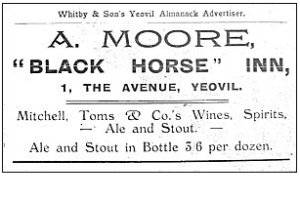 John
Henry Moore,
known as John
Harry, was born
in 1862 at
Stalbridge,
Dorset, the son
of Robert Moore.
Little is known
of his early
life - in 1881
he was a
tailor's
apprentice
living with his
aunt and brother
in Stalbridge
and in December
1891 he married
Amanda Searle in
Yeovil. By 1901
John described
his occupation
as innkeeper and
tailor and lived
in the
King's
Arms,
Silver
Street, with his
wife, Amanda,
and their son,
William. By 1907
John was
licensee of the
Black Horse with
Amanda and
William. John
was listed as
the licensee of
the Black Horse
in Kelly’s 1914
Directory but he
died in the
spring of 1914.
Amanda took on
the license for
a brief period
and was listed
as the licensee
in Whitby's 1915
Yeovil Almanack
Advertiser, with
the
advertisement
shown here.
John
Henry Moore,
known as John
Harry, was born
in 1862 at
Stalbridge,
Dorset, the son
of Robert Moore.
Little is known
of his early
life - in 1881
he was a
tailor's
apprentice
living with his
aunt and brother
in Stalbridge
and in December
1891 he married
Amanda Searle in
Yeovil. By 1901
John described
his occupation
as innkeeper and
tailor and lived
in the
King's
Arms,
Silver
Street, with his
wife, Amanda,
and their son,
William. By 1907
John was
licensee of the
Black Horse with
Amanda and
William. John
was listed as
the licensee of
the Black Horse
in Kelly’s 1914
Directory but he
died in the
spring of 1914.
Amanda took on
the license for
a brief period
and was listed
as the licensee
in Whitby's 1915
Yeovil Almanack
Advertiser, with
the
advertisement
shown here.
MAPs
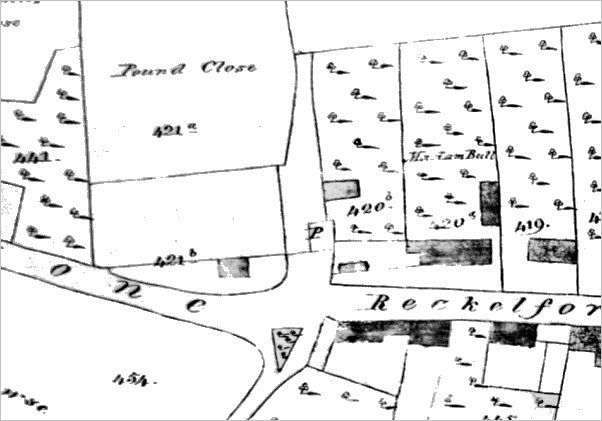
A section of Edward Bullock Watts' map of 1842 showing the field called Pound Close at top left and the track leading to it, also known as Pound Close. The animal pound is shown in the lane and marked with a 'P'. The first incarnation of the Black Horse pub, operating by at least 1835, would have been the small building above and to the left of the 'R' of Reckleford. It would be rebuilt alongside the pound at a later date.
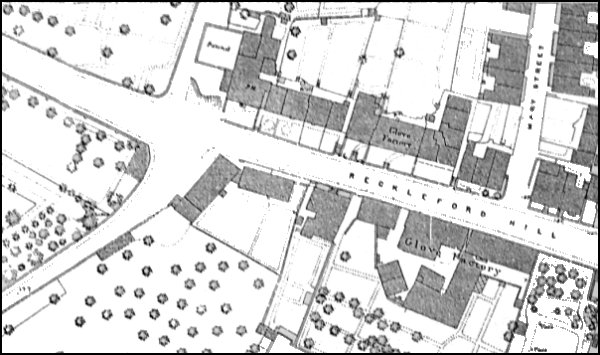
Map based on the 1886 Ordnance Survey showing the Pound at top, left of centre, sitting alongside the Black Horse public house. The track in which the pound was located was called Pound Close.
gallery
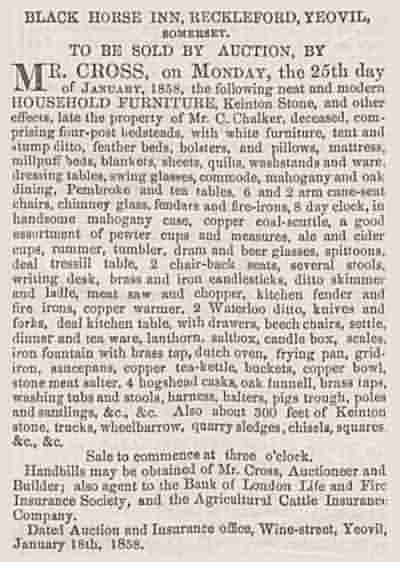
Notice of the sale of household furniture at the Black Horse, following the death of Charles Chalker, from the 19 January 1858 edition of the Western Flying Post.
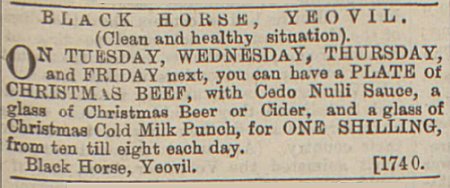
The Black Horse Christmas Special as advertised in the Western Gazette's edition of 22 December 1871. No, I don't know the ingredients of 'Cedo Nulli Sauce'.
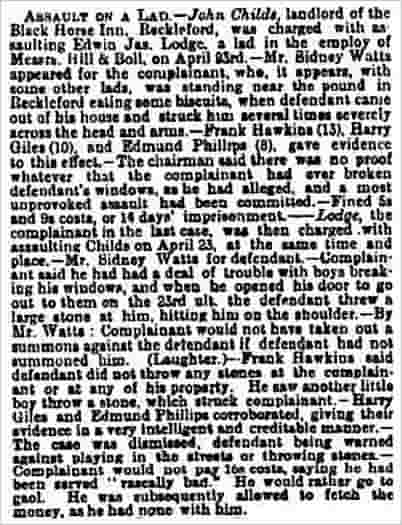
The report of landlord John Childs' assault of a youth from the 6 May 1892 edition of the Western Chronicle.
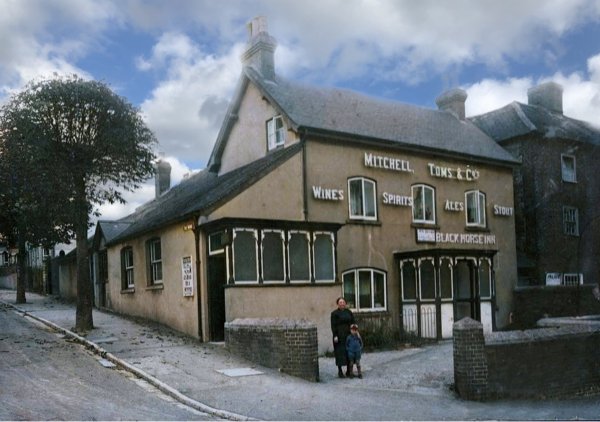
Courtesy of
Brian Kersting
The Black Horse Inn in a colourised photograph of around 1926 - before being rebuilt as we see it today. This building was built between 1842 and 1886 on the site of an earlier pub of the same name.
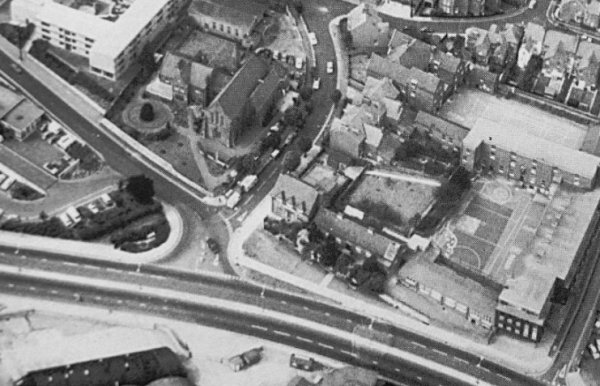
An aerial photograph dating to 1975 shows the Black Horse at the centre with the three dormers. Reckleford, newly made into a dual carriageway, snakes across the lower half of the photograph while Higher Kingston comes down from the top left, past the Catholic church. At this point Higher Kingston ended and Reckleford Hill started, its original course marked by the line of remaining buildings starting with the Black Horse.
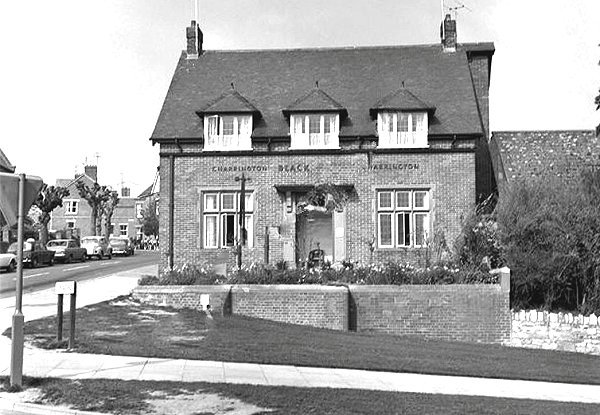
The Black Horse photographed in the 1960s.
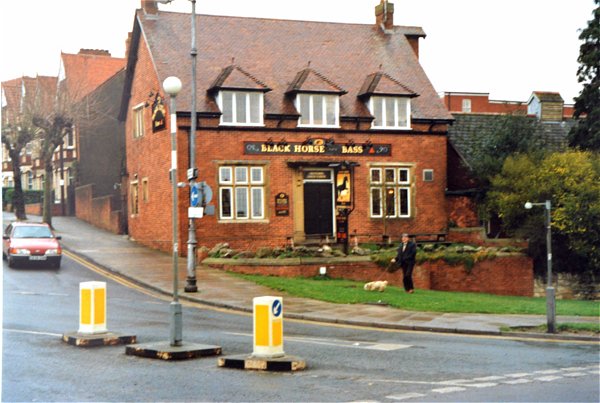
Courtesy of
Chris Rendell
The Black Horse photographed in 1989.
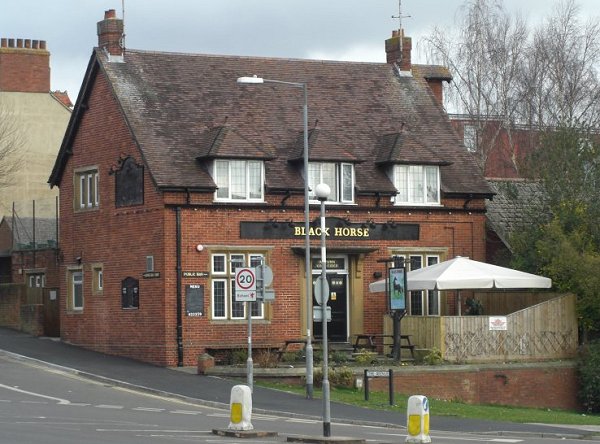
The Black Horse, photographed in 2009.
and finally...
two glazed signs from former times remain today.
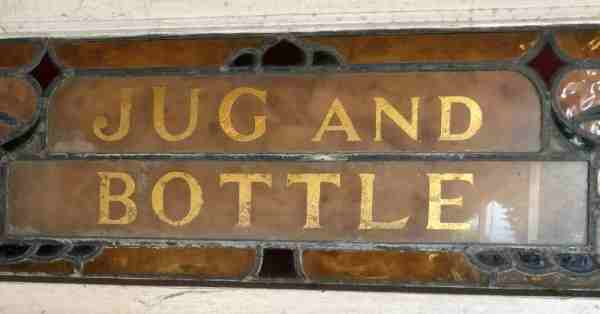
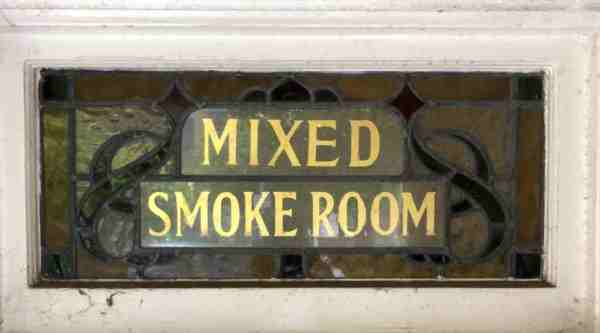
licensees
1835 – Licensee
not named
(Robson’s 1835
Directory)
listed as Black
Horse, Kingston
1839 – George
Bengefield
(Robson’s 1839
Directory)
listed as Black
Horse
1840 – George
Bengefield
(Somerset
Gazette
Directory 1840
-
Inns) listed as
Black Horse
1841 – George
Andrews – Inn
Keeper (1841
census) pub not
named
1842 – Charles
Chalker (Pigot’s
1842-4
Directory)
listed as Black
Horse,
Reckleford
1850 – Charles
Chalker (Hunt &
Co's 1850
Directory - Inns
& Pubs)
1851 – Charles
Chalker - Stone
Mason & Inn
Keeper (1851
census)
1852 – Charles
Chalker – Inn
Keeper (Slater’s
1852 Directory)
– listed as the
Black Horse
1859 – William
Thorne
(Harrison,
Harrod & Co 1859
Directory)
1861 – William
Thorne – Inn
Keeper (1861
census) listed
as Black Horse
Inn
1861 – William
Thorne (Kelly's
1861 Directory)
1871 – Elizabeth
Sugg (55 year
old widow) –
Innkeeper (1871
census) listed
as Black Horse
Inn
1875 – Edwin
Stone (Post
Office Directory
1875) listed as
Black Horse,
Reckleford
1875 – Edwin
Stone (Kelly's
1875 Directory
-
Hotels & Inns)
1881 – Stephen
Dibben – Groom
(1881 census)
listed as the
Black Horse at 1
Reckleford
1882 – Stephen
Dibben (Whitby's
1882 Yeovil
Almanack
Advertiser)
listed as 1
Reckleford
1884 – Stephen
Dibben -
transfer of
license (Petty
Sessions, March)
1884 – John
Winslow -
license
transferred
(Petty Sessions,
March)
1891 – John
Childs –
Proprietor of
Public House
(1891 census) –
listed as Black
Horse Inn
1891 – John
Childs - fined
for selling gin
under proof
(Petty Sessions)
1892 – John
Childs - guilty
of assault on a
youth
(Petty Sessions,
May - see
Gallery)
1894 – Job
Forsey - License
transfer
(Borough Petty
Sessions,
November)
1894 – William
Discombe -
License
transferred
(Borough Petty
Sessions,
November)
1895 – James
Mitchell
(Kelly’s 1895
Directory)
listed as Black
Horse PH
1895 – Robert
Scriven ('the
late') - license
transfer (Petty
Sessions,
November)
1895 – Mrs Mold
- license
transferred
(Petty Sessions,
November)
1898 – Albert
Gill (Whitby's
1898 Yeovil
Almanack
Advertiser)
1899 – Walter
Churchill
(Whitby's 1899
Yeovil Almanack
Advertiser)
1900 – Walter
Churchill
(Whitby's 1900
Yeovil Almanack
Advertiser)
1901 – Mary
Churchill –
Publican (1901
census) listed
as 1 Reckleford
1901 – Edward
Fone –
License transfer
from Walter
Churchill
(Borough Petty
Sessions, May)
1903 – Edward
Fone (Whitby's
1903 Yeovil
Almanack
Advertiser)
1907 – John
Harry Moore
(1907 Yeovil
Directory)
1911 – Mr Moore
(1911 census
Summary) listed
as Public House
but not named
1914 – John
Moore (Kelly’s
1914 Directory)
listed as Black
Horse PH
1915 – Mrs
Amanda Moore
(Whitby's 1915
Yeovil Almanack
Advertiser)
listed as 1 The
Avenue
1916 – Frederick
Driver – License
transfer (April
Borough Police
Court)
1919 – Frederick
Driver (Kelly’s
1919 Directory)
1923 – Frederick
Driver (Kelly’s
1923 Directory)
listed as Black
Horse Inn
1938 – Mary
Driver (1938
Yeovil
Directory)
listed as Black
Horse
1949 – GE Mills
(Kelly’s 1949
Directory)
listed as Black
Horse
1954 – RTA
Denmead (Snell's
1954 Directory)
2012 – Andy
Gurzynski
(Newspaper
article above)
to 2014 then
briefly to the
Butcher's Arms
documentation
|
1865 |
13 November: Proposed by Mr March, seconded - Dawe, that 2s. each be given to 24 men for working at the Fire at the Black Horse. Proposed by Mr March, seconded by - Dawe, that 5s. each be given to Trask and Sugg for assistance at the late Fire. Proposed by Mr Cogan, seconded - Dawe, that £6 be charged for the Fire at the Black Horse. (Volunteer Fire Brigade minutes). |
